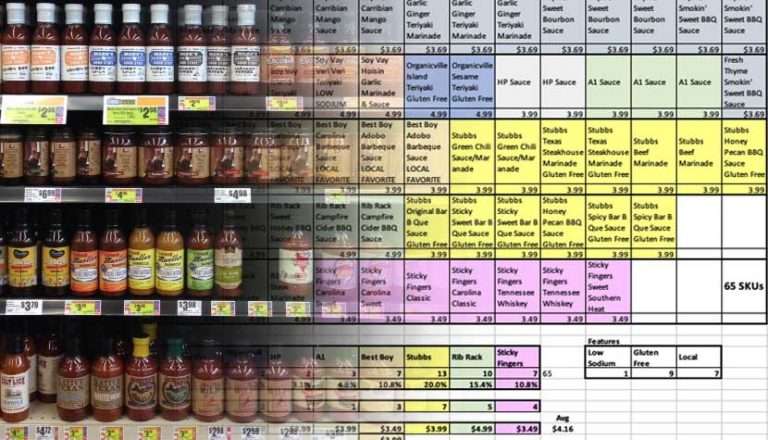Aug 14, 2024
Brand Research for Food Brands  On a Budget
On a Budget
Limited Budget? Not a Good Reason to Skip Brand Research!

The Newpoint team once again finds itself at the start of a new packaging project with an all-important question: what steps can we take to ensure the client’s investment will do the job? Of course, one way is to conduct primary market and brand research. Even if you are on a budget, finding a way to conduct the most basic brand research is still essential.
Brand research is essential for food brands aiming to understand consumer preferences. Knowing your customers’ wants can help tailor your products and marketing strategies to meet their needs. However, conducting thorough brand research can be challenging, especially for food processing and manufacturing companies on a tight budget. These companies often struggle to allocate resources for extensive market research, limiting their ability to gather valuable consumer insights.
This blog post will explore the importance of understanding consumer preferences and companies’ challenges in conducting brand research. We will also provide an overview of budget-friendly strategies to gain insights into your target market. By the end of this post, you’ll have a clearer understanding of conducting brand research without breaking the bank effectively, ultimately helping your brand grow in supermarkets, grocery chains, and online platforms like Amazon.
Section 1: Leverage Brand Research to Understanding Consumer Preferences
Identifying Target Consumers
Understanding your target consumers is crucial for effective brand research. Creating detailed customer profiles helps you grasp both demographics and psychographics. Demographics include age, gender, income, and location, while psychographics cover interests, values, and lifestyle choices. These profiles provide a comprehensive view of your customers and what they want.
To gather consumer data without breaking the bank, consider using inexpensive surveys. Online survey tools like Google Forms or SurveyMonkey offer affordable options to collect valuable insights. You can also leverage social media platforms to ask questions and engage with your audience directly. Another effective method is collecting customer feedback through reviews and comments. This feedback can reveal what consumers love or dislike about your products.
Analyzing Brand Perception
Analyzing brand perception is another vital aspect of brand research. Understanding how your brand stacks up against competitors can guide your marketing strategies. Start by monitoring social media mentions and online reviews to see what consumers are saying about your brand and others. This will help you identify areas where you excel and where you need improvement.
Utilizing customer feedback is a powerful way to assess your brand’s strengths and weaknesses. Encourage customers to share their thoughts through feedback forms or direct messages. Pay attention to recurring themes in their responses. Are they satisfied with your product quality? Do they find your packaging appealing? Use this information to refine your offerings and better meet consumer expectations.
Focusing on these aspects of brand research can help you gain a deeper understanding of your consumers. This knowledge will enable you to tailor your products and marketing efforts to meet their needs, ultimately driving brand growth. Remember, effective brand research doesn’t have to be expensive. You can gather valuable insights without stretching your budget with the right tools and strategies.
Section 2: Brand Research for Packaging and Advertising Insights
Evaluating Packaging Design with Brand Research
Packaging plays a crucial role in consumer decision-making. It can attract attention and influence purchase choices. Effective packaging communicates the brand’s message and values clearly. Understanding packaging’s impact is vital for success in brand research.
To test packaging designs cost-effectively, consider using focus groups. These groups provide direct feedback on design elements and overall appeal. Online surveys are another affordable method. They allow you to gather opinions from a larger audience quickly. Both methods help identify which designs resonate most with consumers. This feedback can guide design improvements and ensure your packaging stands out on the shelf.
Assessing Advertising Claims
Analyzing advertising claims is an essential part of brand research. It’s important to know if your messages are compelling and believable. Start by conducting a competitor analysis. Look at how competitors position their products and what claims they make. This can provide insights into industry standards and consumer expectations.
Using consumer feedback is also crucial in refining your brand messaging. Encourage customers to share their thoughts on your advertising. Are your claims clear and convincing? Do they align with consumer experiences? Use this feedback to adjust your messaging for better impact.
You can enhance your brand research efforts by focusing on packaging and advertising insights. These strategies help you connect with consumers more effectively. They ensure your brand stands out in a competitive market. You can make informed decisions that drive brand growth and consumer loyalty with the right approach.
Section 3: Social Media and Digital Engagement
Identifying Preferred Social Media Platforms
Social media is a powerful tool for brand research. It helps you connect with your audience and understand their preferences. Start by researching which platforms your target audience uses most frequently. Are they on Instagram, Facebook, Twitter, or TikTok? Knowing where your audience spends their time allows you to focus your efforts effectively.
Once you’ve identified the right platforms, develop strategies to engage consumers affordably. Share engaging content that resonates with your audience’s interests and values. Use polls, quizzes, and interactive posts to encourage participation. Collaborate with influencers who align with your brand to reach a wider audience. These strategies can boost your brand’s visibility and foster a loyal community.
Leveraging Social Media for Consumer Insights
Social media offers valuable insights for brand research. Use social media analytics tools to gather data on consumer preferences and trends. Platforms like Facebook Insights and Instagram Analytics provide detailed information about your audience’s behavior. Analyze this data to identify patterns and preferences that can inform your marketing strategies.
Engaging with consumers directly through social media is another effective way to gather feedback. Encourage followers to share their thoughts and experiences with your brand. Respond to comments and messages promptly to build trust and rapport. Host Q&A sessions or live chats to interact with your audience in real-time. This direct engagement can provide valuable insights into consumer needs and expectations.
Focusing on social media and digital engagement can enhance your brand research efforts. These strategies allow you to connect with consumers on a personal level, gaining insights that drive brand growth. With the right approach, social media can be a cost-effective tool for understanding your audience and refining your marketing strategies.
Section 4: Flavor Preferences and Dietary Trends
Methods to Stay Updated on Current Flavor Trends
Staying updated on flavor trends is crucial for successful brand research. Consumers constantly seek new and exciting flavors. Leverage social media and online forums to keep up without a large budget. Platforms like Instagram and Pinterest are great for spotting emerging trends. Follow food influencers and industry experts who often share insights on popular flavors.
Online forums and communities like Reddit can also provide valuable information. Engage in discussions to gauge consumer interest in new flavors. Pay attention to recurring themes and preferences. This approach helps you stay informed about what flavors are gaining traction and which ones might fade away.
Another cost-effective method is to subscribe to newsletters from flavor trend analysts. These resources often provide free reports and updates on the latest trends. By staying informed, you can tailor your products to meet consumer demands and stand out in the market.
Understanding Dietary Restrictions and Preferences
Recognizing dietary trends is essential for effective brand research. Consumers are increasingly conscious of their dietary choices. Trends like vegan, gluten-free, and keto are becoming mainstream. Understanding these preferences can help you cater to a wider audience.
Dietary restrictions often influence purchasing decisions. Consumers look for brands that align with their values and needs. Offering products that cater to these trends can boost your brand’s appeal. Researching these preferences is important to ensure your products meet consumer expectations.
Online surveys and industry reports are affordable ways to research dietary preferences. Use survey tools to gather insights directly from your audience by asking questions about their dietary habits and preferences. This feedback can guide product development and marketing strategies.
Industry reports are another valuable resource. Many organizations publish free or low-cost reports on dietary trends. These reports provide data on consumer behavior and market shifts. Analyzing this information lets you make informed decisions about product offerings and marketing campaigns.
Incorporating flavor trends and dietary preferences into your brand research can enhance product development. It ensures your offerings align with consumer demands and market trends. Stay informed and adaptable, and position your brand for success in a competitive landscape.
Section 5: Price Sensitivity and Consumer Spending
Techniques to Determine Optimal Pricing Strategies for Different Consumer Segments
Understanding price sensitivity is crucial in brand research. It helps tailor pricing strategies to different consumer segments. Start by analyzing your target audience’s income levels, buying habits, and preferences. This data can guide you in setting prices that appeal to each segment.
Competitor analysis is another valuable tool. Study how competitors price similar products. Identify where they succeed and where they fall short. This analysis can reveal gaps in the market that your brand can exploit. By understanding competitors’ pricing, you can position your products more effectively.
Consumer feedback also plays a vital role in setting competitive prices. Gather insights through surveys or direct interactions. Ask consumers what they consider a fair price for your products. Their responses can help you adjust pricing strategies to meet market expectations while maintaining profitability.
Budget-Friendly Brand Research Tools
Conducting market research doesn’t have to be expensive. Many tools and resources are available to help you gather data on a budget. These tools are essential for effective brand research, providing consumer behavior and preferences insights.
Digital tools like SUZY.com and 1Q.com offer affordable data collection and analysis options. SUZY.com provides real-time consumer insights through surveys, helping you understand market trends and preferences. 1Q.com allows you to ask questions and receive instant feedback from a broad audience, making it a valuable resource for brand research.
Additionally, Google Trends is a free tool that tracks search interest over time. It can help identify emerging trends and consumer interests. Social media platforms also offer analytics tools that provide insights into audience demographics and engagement patterns.
Leveraging these budget-friendly tools allows you to conduct comprehensive brand research without straining your resources. These insights will enable you to develop pricing strategies that resonate with consumers and enhance your brand’s competitiveness in the market.
Incorporating price sensitivity analysis into your brand research can significantly impact your pricing strategies. Understanding consumer spending habits and preferences allows you to set prices that attract and retain customers. With the right approach and tools, you can navigate the complexities of pricing in a competitive landscape, ensuring your brand’s success and growth.
Food Brand Research is Key & Accessible!
Understanding consumer preferences is crucial for brand success in today’s competitive food industry. To that end, it is worth exploring the various aspects of budget-friendly brand research, which can provide actionable insights to enhance your marketing strategies.
Understand consumer preferences
Identifying target consumers and creating detailed customer profiles can help you tailor your products and marketing efforts. We also highlighted affordable methods to gather consumer data, such as surveys and feedback, which are essential for effective brand research.
Packaging and advertising insights
Dig into how packaging design influences consumer decisions and shared cost-effective methods for testing designs. Additionally, we discussed assessing advertising claims through competitor analysis and consumer feedback, ensuring your messaging resonates with your audience.
Social media and digital engagement
It is important to identify preferred platforms and engage consumers effectively. Leveraging social media analytics tools can provide valuable insights into consumer preferences and trends, enhancing your brand research efforts.
Flavor preferences and dietary trends.
Staying updated on flavor trends and understanding dietary restrictions can help you cater to consumer demands. We shared affordable ways to research these preferences, ensuring your products align with market trends.
Price sensitivity and consumer spending:
Analyzing price points and using competitor analysis can help you determine optimal pricing strategies. We also introduced budget-friendly research tools like SUZY.com and 1Q.com, which offer valuable insights without straining your resources.
Effective brand research doesn’t have to be expensive. You can gain valuable insights into consumer behavior and preferences by utilizing the strategies and tools discussed. These insights will enable you to refine your products and marketing strategies, driving brand growth and success.
If you’re ready to take your brand research to the next level, contact NewPoint Marketing. Our team of experts is here to help you navigate the complexities of budget-friendly brand research and ensure your brand stands out in the competitive food industry.





 Get it Right
Get it Right
